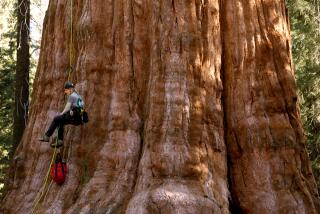Ginkgo bilobaGolden Fossil TreeDeciduous tree to...
- Share via
Ginkgo biloba
Golden Fossil Tree
Deciduous tree to 100 feet
At least 250 million years ago before Homo sapiens evolved or in some other manner pushed through the mists of antiquity, the ginkgo tree dotted the reptile-ridden landscape of the Mesozoic Era.
Of the thousands of plant species existing today, the ginkgo is a remarkable and tenuous link to that remote past. How remote is summed up in a tribute to the ginkgo by the late Sir Albert Seward: “An emblem of changelessness, a heritage from worlds of an age too remote for our human intelligence to grasp, a tree which has in its keeping ‘the secrets of the immeasurable past.’ ”
Charles Darwin called it a “living fossil.”
Only one species, Ginkgo biloba, remains of what was a numerous tribe fossilized in the geological ages. Irreverent botanists tend to disregard its timeless image and lump it in with the conifers. The ginkgo is no more a conifer than it is a cauliflower.
Irreverent horticulturists, casting around for a common name to hang on the ginkgo noted its leaves somewhat resembled a much enlarged leaflet of the maidenhair fern, and the ginkgo became known throughout Western civilization as the maidenhair tree. Honor would have been served had they renamed the maidenhair fern and called it the ginkgo fern.
The Chinese, who have fostered the ginkgo from time immemorial, call it, detractingly, the “duck’s foot tree.”
But honor was served when a group of people from Illinois in March, 1978, realizing that 250 million years is a very long time, hung on the ginkgo the common name of “the golden fossil tree,” that bequeaths a dignity and a bearing to Ginkgo biloba --in token of the autumnal glory it resurrects from prehistoric times. So began the Illinois Golden Fossil Tree Society--which was to become the International Golden Fossil Tree.
It has male and female forms, and trees of the latter gender produce fruits resembling plums, the kernels of which are edible and are a food source in the Orient. Unfortunately, when the fruit falls it gives off a disagreeable odor as the pulp begins to decay. For this reason, it is advisable to plant trees propagated vegetatively from male forms, which are commonly available at nurseries.
The golden fossil tree grows to 100 feet (though most slowly) with a characteristic diagonal upright form, and before dropping, its leaves bring an ethereal radiance and a daffodil glint to the autumn scene.
It is practically free from attacks by insects and disease, a factor attributed to the leathery texture of its leaves.
Those desiring to pay homage to this ancient arboreal ancestor may join the International Golden Fossil Tree Society, 201 W. Graham Ave., Lombard, Ill. 60148.





